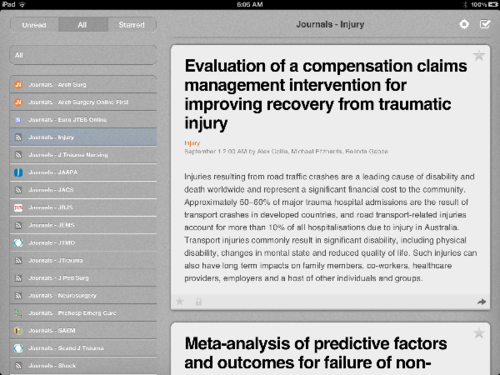Medicine advances quickly. How can one keep up with new developments in their field? Well, there’s an app for that! You can also do it without a handheld device, but it’s not quite as convenient. Let me show you how I do it.
Most regularly updated online content is syndicated for RSS (Rich Site Summary). You know, those cute little  icons on web pages. There are loads of RSS readers available, both online and for handheld devices, that allow you to organize and browse content from RSS feeds. I use Google Reader on desktops or laptops, and the River of News app on my iPad.
icons on web pages. There are loads of RSS readers available, both online and for handheld devices, that allow you to organize and browse content from RSS feeds. I use Google Reader on desktops or laptops, and the River of News app on my iPad.
I visited the home page of each of the journals I was interested in “following” and snagged the RSS web address from each. I then added it to my Google Reader collection of feeds. Now, at some point every day I can quickly browse through new abstracts in each journal. For most journals, abstracts are released once a month. A few publish early release abstracts more regularly.
When you click an abstract of interest, a web page opens that shows the full abstract. If it looks interesting, I save it using Instapaper, a clipping service that helps you organize web pages of interest. I just click a link at the top of the browser and the page is instantly saved for later reference.
As you probably already know, much of what is published is junk. Class III or worse data. Concluding that “additional research is necessary.” So why didn’t you do the study right in the first place? Therefore, it is vitally important that you read the whole article for the abstracts that you have saved. For this, you need access to a biomedical library, either online or brick and mortar. If you’re not lucky enough to have this, you’ll need to rely on others who do. I just run through my list of saved pages on Instapaper and pull up the full article via an online library connection through work.
Here’s a screen shot of my River of News app. I currently monitor 18 journals that publish trauma articles to a greater or lesser degree. I’m also a firm believer that some of the best ideas come from cross-pollinating your own field with ideas from others. To that end, I also scan another 22 feeds in technology, publishing, cooking, aviation and many others. I’m interested in hearing how others do this as well. Please feel free to comment below.

Related links:




